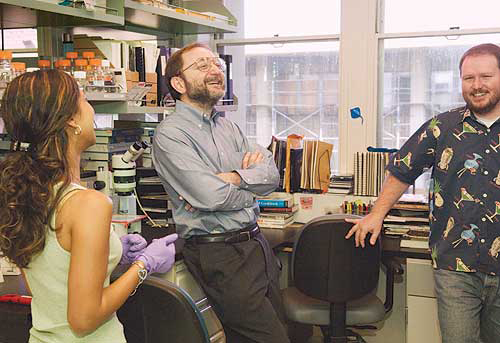October 4, 2006

Andrew Fire, center, receives a warm welcome from graduate student Poornima Parameswaran, left and post doctoral fellow Steve Johnson as he returns to his lab on Tuesday morning.
The discovery of RNA interference—the work that won Andrew Fire and Craig Mello the 2006 Nobel Prize—was published only eight years ago, and it has yet to produce any direct clinical benefits for patients. But its enormous potential has already influenced research at the medical school.
Fire's move to Stanford in 2003 galvanized the formation of an interdisciplinary group of researchers with an interest in RNAi, said Stephen Galli, MD, chair of the Department of Pathology. When Fire arrived, he quickly launched an RNAi journal club, kind of a "scientists' book club," where instead of novels, the focus is research articles.
"He recognized when he joined us that there were many individuals here who were trying to learn about RNAi," said Galli. Bringing them together to discuss RNAi was bound to lead to new directions and collaborations.
"The discovery by Andy Fire and Craig Mello has opened a new window for exploring how genes and their products are regulated and become deregulated," said Paul Berg, PhD, professor of biochemistry, emeritus, and winner of the 1980 Nobel Prize in Chemistry. "Equally important, their findings provide a novel paradigm for the design of new therapeutics." Small inhibitory RNAs could be used to shut down genes causing cancers, as well as combat microbial and virus infections.
Indeed, a number of Stanford researchers are now studying RNAi. For example, microbiology and immunology professor Peter Sarnow, PhD, has looked at how Hepatitis C uses RNAi to grow and reproduce in the liver—the first time the process has been linked to a major infectious disease. Professor of pediatrics and of genetics Mark Kay, MD, PhD, realized that RNAi could greatly expand options for gene therapy and is investigating whether the technique can be used to treat Hepatitis B and C infection.
Chang-Zheng Chen, PhD, assistant professor of microbiology and immunology, has studied RNAi's role in hematopoietic stem cells and as potential diagnostic and therapeutic targets for leukemias and other blood disorders. And Philip Beachy, PhD, who joined the faculty on Sept. 1, just published findings in Nature describing a way of making RNAi screens more accurate.
One way in which Stanford encourages future breakthroughs in RNAi work is by providing an arsenal of research-streamlining methods at the High-Throughput Bioscience Center, a facility that can perform tens of thousands of experiments at the same time. This summer, the center obtained a collection of RNA reagents enabling researchers to screen the entire human genome using RNA-mediated inhibition.
This acquisition of the RNA reagents should enable a wide variety of people to do experiments that would be impossible in an individual laboratory, said Aaron Straight, PhD, assistant professor of biochemistry. "My laboratory has certainly taken advantage of these resources to survey the entire Drosophila genome, and we have already planned our first foray into human cells using the facility," he said. Straight's group has used RNAi to block the efforts of each gene in a fly cell one by one to isolate each gene's effect.
"Andy's discovery has enabled researchers to perform experiments in multi-cellular organisms that would have been unthinkable five years ago," said Straight.
About Stanford Medicine
Stanford Medicine is an integrated academic health system comprising the Stanford School of Medicine and adult and pediatric health care delivery systems. Together, they harness the full potential of biomedicine through collaborative research, education and clinical care for patients. For more information, please visit med.stanford.edu.